Except as noted, article and photos by Joe Sapia
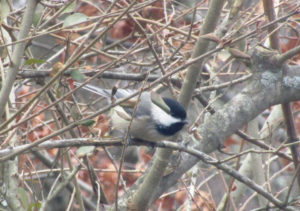
A Carolina chickadee in the front yard shrubbery of my house in Monroe, Middlesex County. Here, looking at the bird through the living room window.
BIRDING THROUGH THE WINDOW: One of my favorite places to watch birds is through my living room window. The love seat, my favorite resting spot, is across from the window, providing the lazy person’s way to birding. Birds perch in the shrubs and, if lucky enough, I take a good photo of them. Recents include the Carolina chickadee, “Poecile carolinensis“; cardinal, “Cardinalis cardinalis”; house sparrow, “Passer domesticus,”; and junco, or “snowbird,” or “Junco hyemalis.
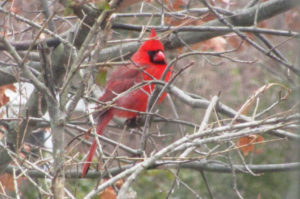
A cardinal outside my living room window, easily identifiable as a male because of its bright red color.
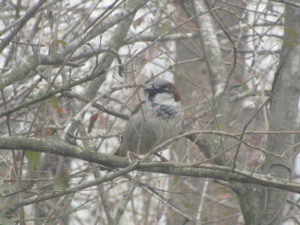
A house sparrow outside the living room window.

Another view of a house sparrow, showing off its colorful pattern.
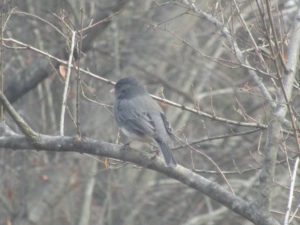
A junco, or “snowbird,” outside the window.
SNOWFALL: Flurries on Sunday, February 4, did not accumulate at my home in Monroe, Middlesex County. But on Wednesday, we had a dusting. So far, the season’s total is 18.5 inches (at my house). The normal seasonal total at New Brunswick, Middlesex County, about 7-1/2 miles away is about 26 inches. We still have about two months left of realistic snow weather.
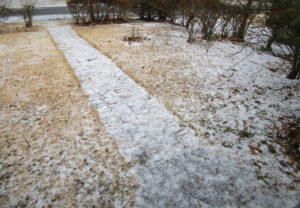
The dusting of snow Wednesday, February 7, in my front yard in Monroe, Middlesex County.
ALONG MANALAPAN BROOK: I live across the street from Manalapan Brook in the house I was “born” in — actually taken to this Monroe, Middlesex County, home from the hospital of my birth. I often escape to a few minutes of woods time by walking the few hundred feet to the Brook. This week, I shot photos there on the snowy Wednesday, February 7, and the rainy-foggy Saturday, February 10. Manalapan Brook’s headwaters are in the area between downtown Freehold, Monmouth County, and the Great Adventure amusement park in Jackson, Ocean County. From its headwaters to where it meets Matchaponix Brook and the two form the South River at Spotswood and Old Bridge in Middlesex County is a straight line of about 15 miles in a direction heading north. It drains 43 square miles in Middlesex and Monmouth counties. The Brook, its floodplain, and surrounding woods are no longer as mysterious and no longer as big (literally and in in my mind) as when I was a kid, but they still provide an adventure. My family has lived along Manalapan Brook since about 1900.
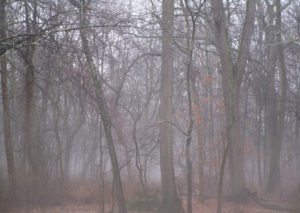
A foggy Saturday, February 10, in the swamp hardwood forest of the Manalapan Brook floodplain.
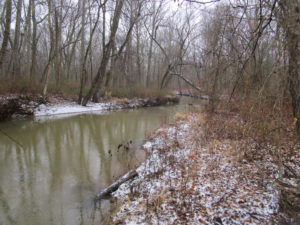
A dusting of snow along Manalapan Brook on Wednesday, February 7.
VOICES FROM AFIELD, RED-SHOULDERED HAWK: Mike Deitche of Monroe checked in with a great photograph of a red-shouldered hawk, “Buteo lineatus,” he took Tuesday, February 6, in Hamilton, Mercer County. “The hawk was on a path as I was walking,” Mike said. “It must have been finishing up its meal when I noticed it. I took three photos (of it) on the ground. Then, it flew up to the top of the tree. It was a lucky shot. I circled around, but it had taken off. I took some photos of the remnants of its meal — looked like breast feathers and tail feathers.”
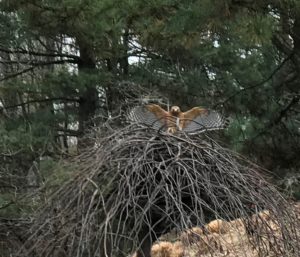
A red-shouldered hawk in Hamilton, Mercer County. “It’s one of our most distinctively marked common hawks, with barred reddish-peachy underparts and a strongly banded tail,” according to Cornell University’s All About Birds website. (Photograph copyright 2018 by Mike Deitche)
LIGHTED CANDLES IN THE WOODS: Pass a forest and you might see leaves of gold on small trees, “lighting” up the woods. These are beech trees, genus “Fagus.” Snow certainly paints a beautiful picture in a winter woods, but when there is no snow, look for these beeches to add some sparkle to the otherwise earthy tones.
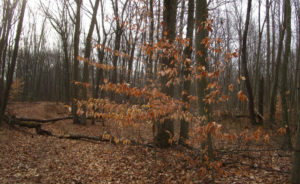
Beech trees “sparkle” at a hardwood forest at Pigeon Swamp in South Brunswick, Middlesex County.
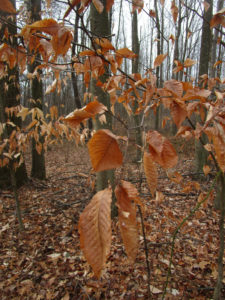
A closeup of a beech tree at Pigeon Swamp in South Brunswick, Middlesex County.
DEBBIE MANS, FROM BAYKEEPER TO DEP: Debbie Mans has watched over the New Jersey-New York Harbor Estuarty for 10 years as director of the New York-New Jersey Baykeeper group, based in Keyport, Monmouth County. Now, Debbie is moving on to be deputy commissioner of the New Jersey Department of Environmental Protection. Debbie is the type of person we need in government — smart, passionate but low key, a leader. As a Jersey boy who went to college in Wisconsin, I appreciate Debbie’s Upper Midwest sensibility — in her case, growing up in Michigan — and, as she put it, now “with a splash of New Jersey.” Congrats, Deb! (A profile I did on Debbie in 2016, September, http://tworivertimes.com/debbie-mans-midwesterner-with-jersey-sand-in-her-shoes/.)
IF YOU THINK YOU HEAR A WOMAN SCREAMING IN THE WOODS…: …I am not saying you should not call the police, but it could just be a red fox, “Vulpes vulpes.” One, perhaps more than one, was really making a racket this week in the woods along Manalapan Brook across the street from my house in Monroe, Middlesex County. A year or so ago, my neighbor called the police after he and his wife heard what sounded like a woman being dragged through the woods, screaming. An example of a fox scream, https://www.youtube.com/watch?v=zk1mAd77Hr4.
VERNAL PONDS: A New Jersey Division of Fish and Wildlife website defines vernal ponds as “confined depressions, either natural or man-made, that hold water for at least two consecutive months out of the year, and are devoid of breeding fish populations.” Vernal ponds, or “vernal pools, pools provide habitat to many species of amphibians, insects, reptiles, plants, and other wildlife,” according to Fish and Wildlife. “The absence of fish is the essence of these ecosystems. Fish are highly predatory on amphibian eggs and larvae. Over the course of evolution, several species of salamanders and frogs exploited these fish-less water bodies. Today, these species exhibit ‘hardwired’ instincts and behaviors that are geared exclusively towards fish-free aquatic habitats.” As warmer weather approaches, keep an eye on vernal pools and the wildlife they produce.
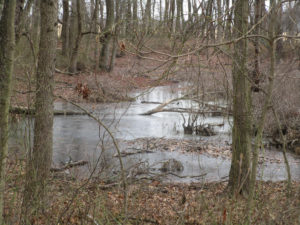
vernal pond at Pigeon Swamp in South Brunswick, Middlesex County.
ATLANTIC OCEAN TEMPERATURES: The Atlantic Ocean temperature along the New Jersey coast was running at about 35 to 37 degrees over the February 10-11 weekend.
SUNRISE/SUNSET: From Sunday, February 11, to Saturday, February 17, the sun will rise about 6:45 to 6:55 a.m. and set at about 5:30 to 5:35 p.m. From Sunday, February 18, to Saturday, February 24, the sun will rise about 6:40 to 6:45 a.m. and set 5:35 to 5:45 p.m.
WEATHER: The National Weather Service forecasting office serving the Jersey Midlands is at http://www.weather.gov/phi/.
UPCOMING:
March 3, Saturday, 10 a.m. to 1:30 p.m., Somerset County — Deer Management Symposium at the Elks Lodge, 354 Route 518, Montgomery, free. Different stakeholders are to discuss deer management. More information is available at info@sourland.org.
March 10, Saturday, 11 a.m. to 12:30 p.m., Ocean County — Science Saturday, talk on striped bass management and fishing by Brendan Harrison, a New Jersey Division of Fish and Wildlife fishing technician,at the Long Beach Island Foundation of Arts and Sciences, 120 Long Beach Boulevard, Loveladies, 08008, $5 for non-members. More information at telephone 609-494-1241.
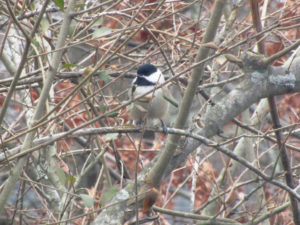
The Carolina chickadee in front of my living room window.
— Joseph Sapia
2018, February 11, Sunday,
In the Pine Barrens around Helmetta, Middlesex County,
Joe Sapia, 61, is a lifelong resident of Monroe — in South Middlesex County, where his maternal family settled more than 100 years ago. He is a Pine Barrens naturalist and an organic gardener of vegetables and fruit, along with zinnias and roses.
He draws inspiration on the Pine Barrens around Helmetta from his mother, Sophie Onda Sapia, who lived her whole life in these Pines, and his Polish-immigrant grandmother, Annie Poznanski Onda.
He gardens the same backyard plot as did his Grandma Annie and Italian-American father, Joe Sr. Both are inspirations for his food gardening. Ma inspires his rose gardening.
Joe is a semi-retired print journalist of almost 40 years. His work also is at @JosephSapia on Twitter.com, along with Facebook.com on the Jersey Midlands page.
Copyright 2018 by Joseph Sapia
Except as noted, article and photos by Joe Sapia
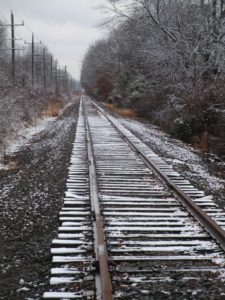
On the ConRail railroad tracks between Prospect Plains and Cranbury Station on the boundary of Cranbury and Monroe, Middlesex County.
JEEP-LESS, THE BAD: My Jeep Wrangler has been in the shop. A metal plate in the clutch area cracked. When mechanic-friend Frank Ulatowski told me the parts distributor said, I never ordered this part before, I knew this could be trouble. The part, being shipped from Detroit, finally did come in and Frank installed it, but the repair was set back by the need for a second part. The Jeep should be ready Monday. For the past week, though, my travels have been limited – generally confined to walking in my hometown of Monroe and the bordering towns of Helmetta, Spotswood, South Brunswick, Cranbury, and Jamesburg.
JEEP-LESS, THE GOOD: With no work scheduled, I decided to not rent a motor vehicle, instead hoofing it. I have thought about this for years – on my days not working, try to only walk or bicycle. So, I have been constantly walking, along with some bicycling. My longest walk was 11 miles – a trek home from the doctor’s office for a followup on my annual exam in Monroe (to which I taxied), with a detour to Teddy’s luncheonette in Cranbury and, later, supper in Helmetta. Aside from the health benefits of walking, it has taken me on routes less-traveled and slowed me to observe better. So, I have a lot of cool observations to pass along.
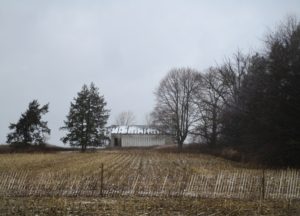
An old farm site in Cranbury.
SNOWFALL UPDATE: The two snowfalls on Tuesday, January 30, amounted to an estimated 1.0 inch of snowfall at my Monroe house. This brings the seasonal total to 18.0 inches. The normal season average is about 25.8 inches, recorded in New Brunswick, about 7-1/2 miles away; We still have about 2-1/2 months of snow potential to reach the average.
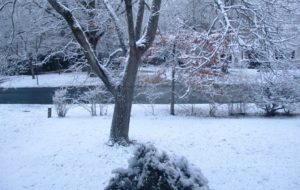
The view I awoke to, as seen from my bedroom window, on Tuesday, January 30, in Monroe.
‘POWDERED SUGAR’ SNOW: When I awoke Tuesday, January 30, I found a snowfall that looked as though the vegetation was covered with powdered sugar. It was a beautiful find to start the day!
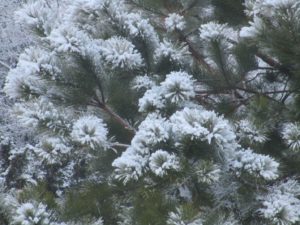
The “powdered sugar” snow on the pitch pine, “Pinus rigida,” in my backyard in Monroe.
NORTHERN HARRIERS, CONTINUED: I continue to see northern harriers, “Circus cyaneus,” more than I have ever seen. This week, I saw one at Helmetta Pond, Middlesesex County – the first time I recall seeing one there. Remember, as a nester, New Jersey lists them as “endangered,” or in imminent peril. Look for them hunting game by flying low above fields or marshes. They are sleek and have a white rump patch – females are brown, males are gray-white. As Roger Dreyling, birder extraordinaire from Monroe, noted, “I like harriers, especially males, which are sometimes called ‘gray ghosts.’”
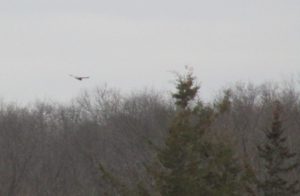
A female northern harrier at Helmetta Pond. Notice the white rump patch.
UPPER MILLSTONE RIVER EAGLES NEST: Anne Price and I, volunteers for the state Department of Environmental Protection, have been watching this nest. We agree it appears the eagles are incubating an egg or eggs. For example, I saw an eagle fly by the nest and perched nearby, while it appeared the other one was in the nest. Because bald eagles are a jeopardized species in New Jersey – “endangered,” or under imminent threat as a nester, and “threatened,” or could become “endangered” if conditions persist, in general – we are being discreet in identifying the location of the nest. (In the 2017 state eagles report, http://www.state.nj.us/dep/fgw/ensp/pdf/eglrpt17.pdf, this nest is listed as No. 184, “Upper Millstone.”)
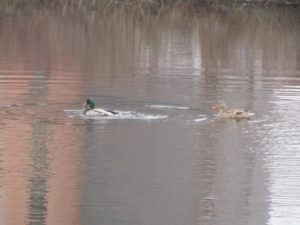
Mallard ducks, “Anas platyrhynchos,” at a fire-suppression pond at the former George W. Helme Snuff Mill in Helmetta. The more colorful male is on the left.
VOICES FROM AFIELD, EAGLE SIGHTINGS: I keep saying, if you want to see bald eagles, look up into the sky. Various reports came in during the week week. Michele Arminio of Monroe reported seeing a flying eagle at Milltown Road, between Route 18 and Ryders Lane, in East Brunswick. Janice Weinman reported seeing one at the South River and its wetlands on the boundary of Old Bridge, Sayreville, and East Brunswick: “Flying out of the marshlands area on the east side of Bordentown Avenue, flying towards east Brunswick. It was an adult as it had its white head, but not too big. I was surprised to see one there. I was not aware of any in that area.” Actually, this one could be nesting in the Old Bridge area. A pair, there, has repeatedly moved its nest and, last year, a nest could not be located. Paul Reed reported an eagle at Helmetta Pond. Roger Dreyling of Monroe reported an immature eagle at “Jamesburg Lake” (Lake Manalapan) in Monroe. Duke Farms in Hillsborough, Somerset County, has a camera on its eagle nest, http://dukefarms.org/making-an-impact/eagle-cam/.
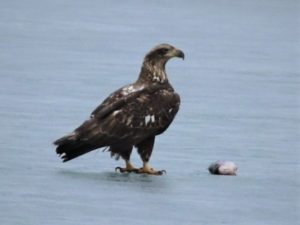
An immature bald eagle – notice the lack of white head and tail – with a fish at “Jamesburg Lake” (Lake Manalapan) in Monroe in January. (Photograph copyright 2018 by Roger Dreyling)
MUTE SWANS: Ugh, I dislike mute swans, “Cygnus olor,” non-natives that hurt local ecosystems through their aggressive eating of aquatic vegetation and scaring off native species. But they are naturalized here…. This week, I saw a pair at Helmetta Pond.
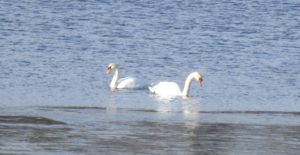
Mute swans on Helmetta Pond.
BACKYARD SHRUB PILE: I keep a pesticide- and fertilizer-free yard. It is only a quarter-acre, or about 10,000 square feet. But it is productive — a vegetable and fruit garden of more than 1,000 square feet, bird-feeders, bird baths. Roughly only 10 percent of rainwater drains off the property. One of the pro-environment bits of my property is the brush pile and tall-grass patch I keep in the backyard. The brush pile, for example, is a place for birds to retreat to and perch. This week, I photographed a few house sparrows, “Passer domesticus,” is the pile. (I was happy to see the brush pile being used, despite being used by house sparrows, a non-native species.)
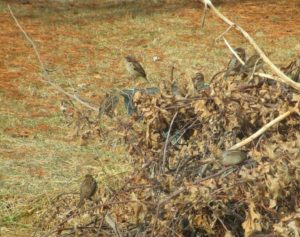
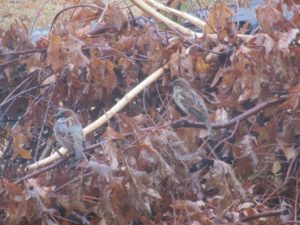
House sparrows in the backyard bush pile.
OTHER YARD BIRDS: I took random photos of various bird species in my yard: cardinal, “Cardinalis cardinalis”; dark-eyed juncos, “Junco hyemalis,” or “snowbirds”; red-bellied woodpecker, “Melanerpes carolinus”; and grackles, “Quiscalus quiscula.”
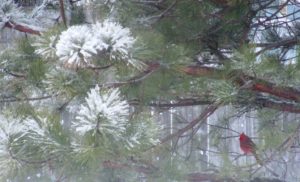
A cardinal, “Cardinalis cardinalis,” in the backyard pitch pine.
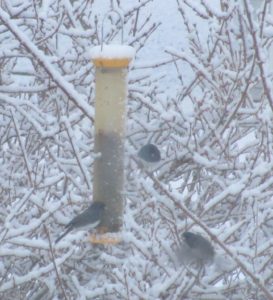
Snowbirds – one at the niger feeder, one perched nearby, one flying in.

Red-bellied woodpecker at the sunflower kernel feeder.
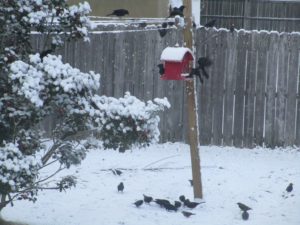
Grackles at the feeder.
VOICES FROM AFIELD, ROBINS: “Polish Paul” Migut, a friend going back to childhood, checked in on robins, “Turdus migratorius.” He, too, had them in his South River yard. “Thursday (February 1) morning, looking into my rear yard, spotted about 10 to 12 robins,” Paul said. “Looked very healthy, plump.” Again, some may consider a robin as a sign of spring, but they are year-around.
RED-TAILED HAWKS: This week, I was able to get some pretty close-up photographs of red-tailed hawks, “Buteo jamaicensis.” Looked for them perched, soaring with a creamy underbelly look and rust-colored tail, or a big bird flying and flapping its wings about a half-dozen times.
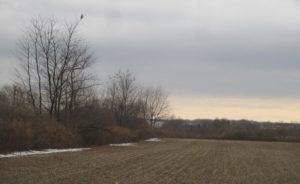
A red-tailed hawk perches in a tree and watches over farmland in South Brunswick.
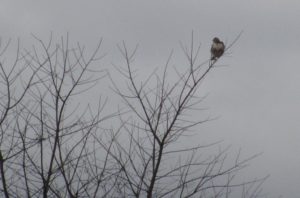
A closeup of the South Brunswick red-tailed hawk.
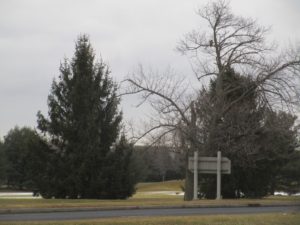
A red-tailed hawk perches in a tree near New Jersey Turnpike Exit 8-A in Monroe.
DEAD GREAT BLUE HERON: I was hiking in the Pine Barrens around Helmetta and at Cranberry Bog came across a dead blue heron, “Ardea Herodias.” It was lying on dry ground, inches from the water. Its eyes were in place and its body supple, so it probably was not dead all that long. I saw no obvious cause of death. Its anal area was ripped up a bit, but that likely was caused by a scavenger after death. I talked to Rick Lear, head of the Middlesex County Office of Parks and Recreation, about it and he speculated it died of starvation, because of the difficulty of finding food, such as aquatic animals and small mammals, this time of year.
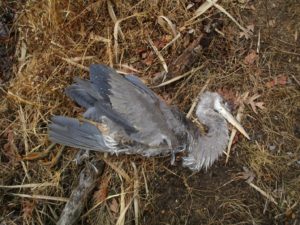
A great blue heron I found dead at Cranberry Bog in Monroe.
FARMLAND, DEVELOPABLE LAND: I recall saying, “Potatoes like dry feet and so do developers.” Well, look at this gravelly, or well-drained, farmland in South Brunswick. Nice developable land, unfortunately! Even more unfortunate is it being located on the New Jersey Turnpike, near an exit, 8-A.
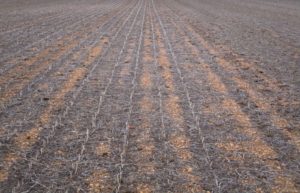
Gravelly farmland in South Brunswick.
PHRAGMITES: I am noticing a lot of invasive reed grass, genus “Phragmites.” This stuff really clogs wetlands and is difficult to control. It is not only bad for the environment, but also for drainage. Beware in heavy rain, this will contribute to flooding. And phragmites invasion is only getting worse, from what I see.
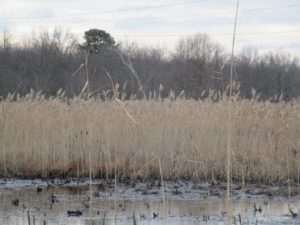
Phragmites clogging Cranberry Bog in Monroe.
BARKING FOX: One night, I stood in my yard and listened to this yip, yip, yip call from the woods or near the woods. It was a red fox, “Vulpes vulpes.” So, do not only look, but listen. Nature is all around us.
NON-POINT SOURCE POLLUTION: I was walking in the Manalapan Brook floodplain in Helmetta and there it was, non-point source pollution – garbage — that got into the water system and floated about. Ever seen those notices about garbage getting into storm drains? They really mean it. Throw a plastic bottle out of a car miles inland and, at least in theory, it could wind up in the ocean. Even if it does not wind up in the ocean, it could wind up in the freshwater system. And even if it does not do that, it is still litter.
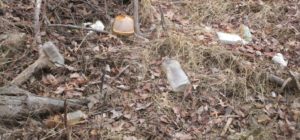
Non-point source pollution in the Manalapan Brook floodplain at Helmetta.
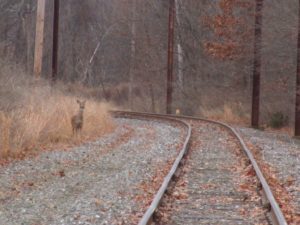
ATLANTIC OCEAN TEMPERATURES: The Atlantic Ocean temperature along the New Jersey coast was running at about 35 to 37 degrees on the February 3-4 weekend.
SUNRISE/SUNSET: From Sunday, February 4, to Saturday, February 10, the sun will rise about 7 a.m. and set 5:25 p.m. From Sunday, February 11, to Saturday, February 17, the sun will rise about 6:45 to 6:55 a.m. and set at about 5:30 to 5:35 p.m.
WEATHER: The National Weather Service forecasting office serving the Jersey Midlands is at http://www.weather.gov/phi/.
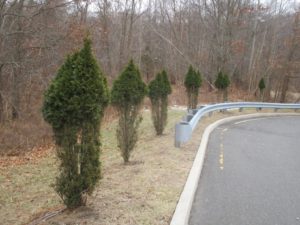
Deer damage to arbor vitae trees at the old George W. Helme Snuff Mill power plant in the Helmetta.
Joe Sapia, 61, is a lifelong resident of Monroe — in South Middlesex County, where his maternal family settled more than 100 years ago. He is a Pine Barrens naturalist and an organic gardener of vegetables and fruit, along with zinnias and roses. He draws inspiration on the Pine Barrens around Helmetta from his mother, Sophie Onda Sapia, who lived her whole life in these Pines, and his Polish-immigrant grandmother, Annie Poznanski Onda. He gardens the same backyard plot as did his Grandma Annie and Italian-American father, Joe Sr. Both are inspirations for his food gardening. Ma inspires his rose gardening. Joe is a semi-retired print journalist of almost 40 years. His work also is at @JosephSapia on Twitter.com, along with Facebook.com on the Jersey Midlands page.
Copyright 2018 by Joseph Sapia
Except where noted, article and photos by Joe Sapia
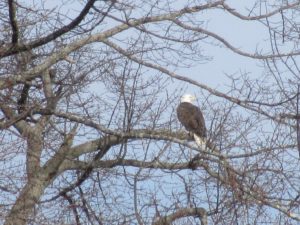
A bald eagle perched in a tree near its “Upper Millstone River” nest on the boundary of Middlesex and Mercer counties.
UPPER MILLSTONE RIVER EAGLE NEST: As the state Department of Environmental Protection monitors of the nest, Anne Price and I have been watching the pair of bald eagles, “Haliaeetus leucocephalus.” By week’s end, they were still in pre-nesting mode – flying in courtship, perched near each other near the nest, perched together on the nest. Stay tuned, there should be an egg or eggs during the week of January 28. Because bald eagles are a jeopardized species in New Jersey – “endangered,” or under imminent threat as a nester, and “threatened,” or could become “endangered” if conditions persist, in general – we are being discreet in identifying the location of the nest. (In the 2017 state eagles report, http://www.state.nj.us/dep/fgw/ensp/pdf/eglrpt17.pdf, this nest is listed as No. 184, “Upper Millstone.”)
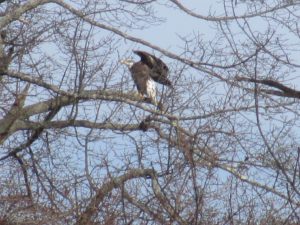
The eagle, spreading its wings, on a tree near the nest.
NORTHERN HARRIERS: I love northern harriers, “Circus cyaneus,” flying low above fields, searching for mammals to eat. They glide eloquently, putting on quite a show. This week, I was watching them on the Monroe-Cranbury boundary, Middlesex County – one at the wetlands mitigation bank at Cranbury Station, then around the wetlands mitigation bank at Wyckoff’s Mills. I did not get a good look at the Cranbury Station “marsh hawk,” but watched the Wyckoff’s Mills one for several minutes, flying back and forth, seemingly unbothered by me. The glimpse I got of the Cranbury Station harrier suggested it was a male, because it looked to be light-colored. The Wyckoff’s Mills harrier was a female – brown in color. Harriers, whether male or female, are easy to identify – flying within feet of the ground, sleek-bodied, having a white rump patch.
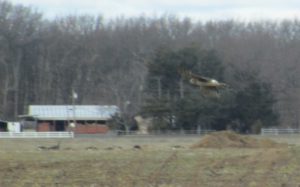
A northern harrier flies across farmland in at Wyckoff’s Mills on the Cranbury, Middlesex County, side of the road. Brown in color means it is a female. Notice the white rump patch females and males both have.

The female northern harrier flies above the wetlands mitigation bank on the Monroe side of the road at Wyckoff’s Mills, Middlesex County.

The female northern harrier flies on the Monroe side of the road at Wyckoff’s Mills, Middlesex County.
BLACK SQUIRRELS: If you want to see black squirrels, check out Princeton or Cranbury. Several years ago, I heard a story, although I do not know if it is true, that someone from Cranbury went to Princeton, trapped some black squirrels, and brought them to Cranbury. Actually, black squirrels are just a black phase of a gray squirrel, “Sciurus carolinensis.” Gray squirrels have no gray hairs — only white, black, and brown with the combination giving them a varied appearance.
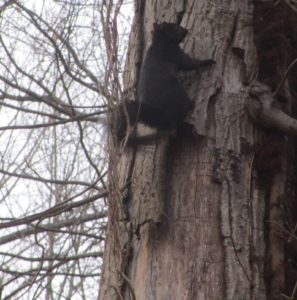
A black-phase gray squirrel in the woods between Wyckoff’s Mills and Cranbury Station in Cranbury, Middlesex County.
DEER IN THE DAYTIME: Twice in one day, I saw deer, “Odocoileus virginianus,” seemingly unbothered in the daytime in areas with a lot of human traffic. At noon, I saw one in a residential area on Riva Avenue, East Brunswick, Middlesex County. Then, 3-1/2 hours later, one was in a lawn area of Thompson Park, Monroe, Middlesex County. I thought this daytime lack of fear of these deer was brazen.
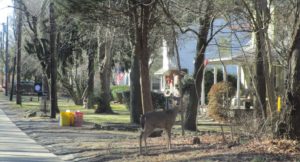
The deer on Riva Avenue in East Brunswick, Middlesex County.
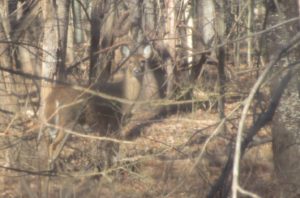
The East Brunswick deer fled me, then checked me out from the relative safety of the woods.
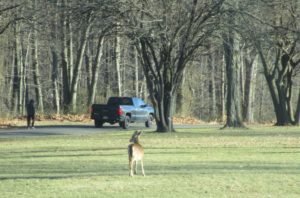
A deer in Thompson Park in Monroe, Middlesex County
ROBINS, A SIGN OF SPRING?: Some may think of robins, “Turdus migratorius,” are a sign of spring. But, actually, they are around in the winter. Perhaps more in the woods this time of year because of berries as a food source. Then, as it warms, with insects and worms becoming available, in our yards where we readily see them. But a little group of robins popped into my yard, across from woods, this week. (I have this affection for robins, because, I think, it was the first bird I learned to identify as a child.)
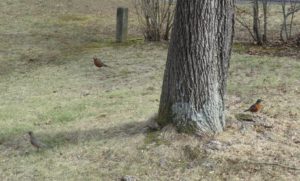
Robins in my front yard in Monroe, Middlesex County.
BIRDS, STARLINGS: Recently, I have noticed flocks of starlings, “Sturnus vulgaris.” The photograph shows them on farmland in Monroe, Middlesex County. (They are non-native, brought from Europe to North America in the 1800s and, now, naturalized here.)
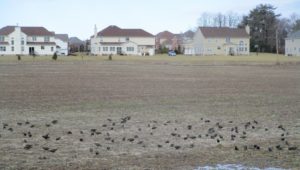
A flock of starlings on farmland in Monroe, Middlesex County.
YARD BIRDS: I was able crank off photographs of a white-throated sparrow, “Zonotrichia albicollis,” in one of my favorite bird-watching areas – through my living room window in Monroe, Middlesex County.
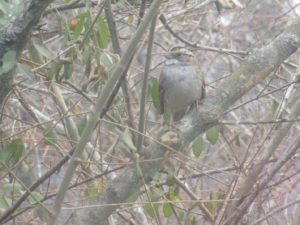
A white-throated sparrow in my front yard in Monroe, Middlesex County.
STINK BUGS: With the cold weather, I have an occasional brown marmorated stink bug, “Halyomorpha halys,” invading my house. I exterminate them. Their stink is not bad – more an earthy organic smell than a nauseating one. But they are highly invasive non-natives that could be devasting to farming. They have been documented for only about 20 years, believed to have arrived from East Asia to the Allentown, Pennsylvania, area via cargo. See https://njaes.rutgers.edu/stinkbug/.
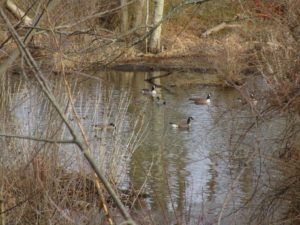
Canada geese, “Branta canadensis,” and mallard ducks, “Anas platyrhynchos,” along the Millstone River in East Windsor, Mercer County.
JERSEY MIDLANDS PRECARIOUS LOCATION: The beautiful Jersey Midlands are situated precariously between two major metropolitan areas, New York City and Philadelphia, and in the heart of the Boston-to-Richmond megalopolis. So, we are under development pressure. But, sometime, when we see our natural world beauty, we may forget how close we are. Reminders are the ongoing development (and destruction of the Midlands); traffic on the New Jersey Turnpike, Garden State Parkway and elsewhere; jets passing overhead.

A view of the New York City skyline – the Freedom Tower, center, and the Empire State Building, just to the right of the utility line tower – through the eye of a point-and-shoot camera about 35 miles away from Redmond’s Hill at Thompson Park in Monroe, Middlesex County.
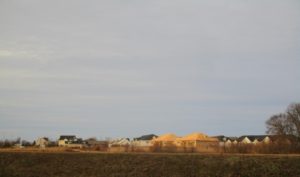
Here is an example of that development – in what I grew up calling “The Farms” of Monroe, Middlesex County.
PEGGY RENNER, ARCHERY CHAMP: I stumbled upon an obituary for Peggy Renner, who died this week. She and her family ran an archery-outdoors store in the Jamesburg-Monroe area for years. A salute to Peggy. Peggy’s obituary, http://www.legacy.com/obituaries/mycentraljersey/obituary.aspx?n=margaret-w-renner&pid=188001769&fhid=27060.
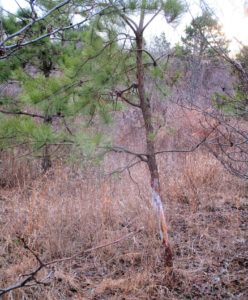
A deer rub of a male deer, “Odocoileus virginianus.” Bucks will rub the velvet off their antlers because they are hormonal and ready to mate, along with declaring their mating turfs. This is a pretty big rub, so there must be a pretty big buck around the Wyckoff Mills wetlands bank on the Monroe-Cranbury boundary, Middlesex County.
SWEET GUM TREE: Seeds from the pods of sweet gum, “Liquidambar styraciflua,” are a food for wildlife. This Internet site shows artsy uses for the seed pods, https://www.pinterest.com/beckyblue65/sweetgum-tree-seed-pods/.
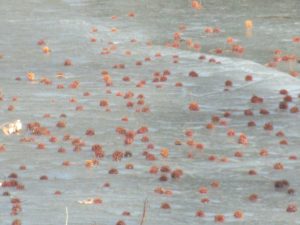
Seed pods of the sweet gum tree dot the ice of Devil’s Brook on the boundary of Plainsboro and South Brunswick, Middlesex County.
TURKEY VULTURES: We may note turkey vultures, “Cathartes aura,” flying V-winged or eating roadkill. They are a common bird. This week, I caught two interesting photos, one of them on a roadkill, the other in silhouette illustrating their look.
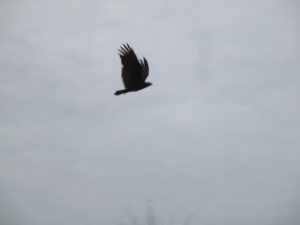
A turkey vulture. From Cornell University’s All About Birds website, “…They have long ‘fingers’ at their wingtips and long tails that extend past their toe tips in flight” — both evident in the photograph.
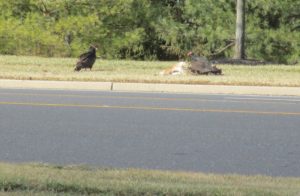
Turkey vultures on a deer carcass on Route 535 in Cranbury, Middlesex County.
SKY VIEWS: This week’s sky photographs are from Middlesex County – Cranbury and Monroe.

A farmland scene between Applegarth and Wyckoff’s Mills in Monroe, Middlesex County.
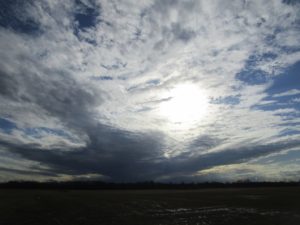
Again, a farmland scene between Applegarth and Wyckoff’s Mills in Monroe, Middlesex County.
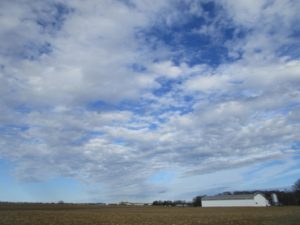
And, again, a farmland scene between Applegarth and Wyckoff’s Mills in Monroe, Middlesex County.

Wyckoff’s Mills farmland in Cranbury, Middlesex County.

Looking toward Applegarth in Monroe, Middlesex County.
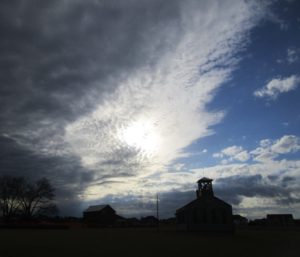
At the Dey Farm historic site in Monroe, Middlesex County.
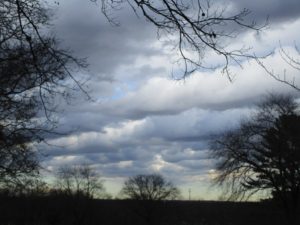
At Thompson Park in Monroe, Middlesex County.

At Saint James Cemetery in Monroe, Middlesex County.

Farmland in Cranbury, Middlesex County.
ATLANTIC OCEAN TEMPERATURES: The Atlantic Ocean temperature along the New Jersey coast is running at about 35 or 36 degrees.
WEATHER: The National Weather Service forecasting office serving the Jersey Midlands is at http://www.weather.gov/phi/.
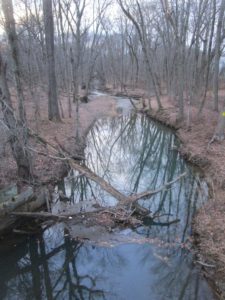
Cranbury Brook, here at Cranbury, Middlesex County, is part of the Raritan River watershed. Cranbury Brook runs from the Route 33 area at Millstone and Manalapan in Monmouth County.
SUNRISE/SUNSET: For Sunday, January 28, to Saturday, February 3, the sun will rise about 7:05 a.m. to 7:10 a.m. and set about 5:10 p.m. to 5:20 p.m.
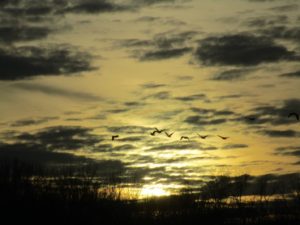
Canada geese flying at sunset on the border of Cranbury and Monroe, Middlesex County.
Joe Sapia, 61, is a lifelong resident of Monroe — in South Middlesex County, where his maternal family settled more than 100 years ago. He is a Pine Barrens naturalist and an organic gardener of vegetables and fruit, along with zinnias and roses. He draws inspiration on the Pine Barrens around Helmetta from his mother, Sophie Onda Sapia, who lived her whole life in these Pines, and his Polish-immigrant grandmother, Annie Poznanski Onda. He gardens the same backyard plot as did his Grandma Annie and Italian-American father, Joe Sr. Both are inspirations for his food gardening. Ma inspires his rose gardening. Joe is a semi-retired print journalist of almost 40 years. His work also is at @JosephSapia on Twitter.com, along with Facebook.com on the Jersey Midlands page.
Copyright 2018 by Joseph Sapia
Article and photos by Joe Sapia
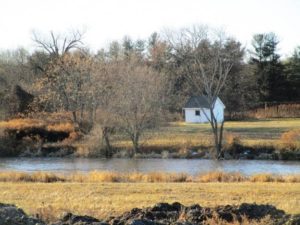
A farm outbuilding in Hopewell Township, Mercer County.
UPPER MILLSTONE RIVER EAGLE NEST: Last year’s pair of bald eagles, “Haliaeetus leucocephalus,” has returned to its nest along the Millstone River corridor on the boundary of Middlesex and Mercer counties. Last year, the nest fledged one eaglet. The state Endangered and Non-Game Species Program (within the Department of Environmental Protection’s Division of Fish and Wildlife) has named Anne Price, a professional naturalist and fellow Monroe, Middlesex County, resident, and me as the volunteer monitors for the nest. The eagles were still in pre-nesting phase, but we expect an egg or eggs to be laid any day now. More good news to follow next week. (In the 2017 state eagles report, http://www.state.nj.us/dep/fgw/ensp/pdf/eglrpt17.pdf, this nest is listed as No. 184.)
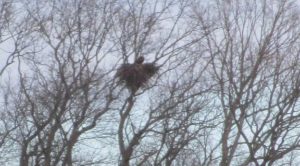
A bald eagle perched on the Upper Millstone River nest on the boundary of Mercer and Middlesex counties. This pair appears ready to lay an egg or eggs soon.
SNOWFALL: The Wednesday, January 17, snowfall in the part of Monroe between Jamesburg and Helmetta, Middlesex County, was about 1.0 inches, bringing the seasonal total to about 17.0 inches. (The seasonal average, measured at New Brunswick about 7.5 miles away, is 25.8 inches. So, we need only about 9 more inches to hit the average and we have about 3 months of snow time left.)
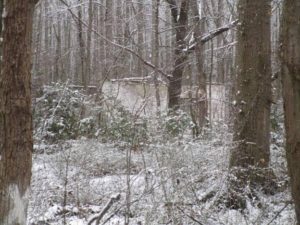
Snowy woods with an abandoned building on Federal Road in Monroe, Middlesex County.
SNOWFENCING: I have talked about snowfencing in open areas before and how it prevents drifting on roadways. Also, I have posted photos. But, perhaps, the post-snowfall scene best describes snowfencing, how snow is deposited on the downwind side. A photograph of the post-snowfall scene:
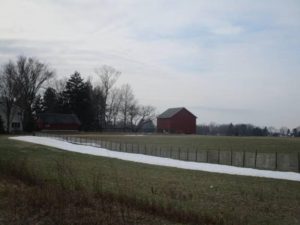
Here, on Main Street in Cranbury, Middlesex County, snow has deposited on the downwind side of the snowfencing. This same concept is used to contain blowing sand on beaches.
CANADA GEESE: I have been seeing a lot of Canada geese, “Branta canadensis,” on farmland, presumably helping themselves to leftover field corn in these fields. And I keep an eye out to see if there is anything else mixed in with these Canadas, perhaps a snow goose, “Chen caerulescens.”
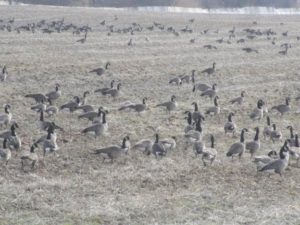
Canada geese on farmland in Cranbury, Middlesex County.
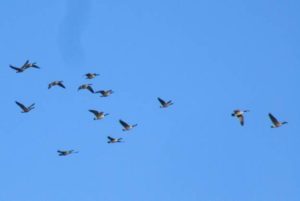
Canada geese flying in Hopewell Township, Mercer County.
BIRDS AROUND THE YARD: We have an incredible world of nature around us in New Jersey. We are at a prime location, where northern and southern animal and plant species meet. One easy thing to do is take time to view the birds in one’s yard. I feed them, using sunflower kernels/hearts nyger. (Last year, though, I stopped feeding birds in the summer, letting them serve as a natural pesticide in my yard. This year, I may extend this feeding ban beyond June, July, and August to a greater gardening period.)
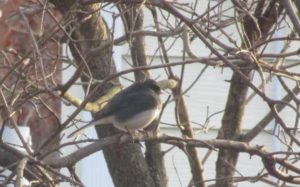
It is a “snowbird” – or dark-eyed junco, “Junco hyemalis” – but it is bundled up against the cold. This junco, in an oak, genus “Quercus,” in my sideyard, has its feathers fluffed to protect it against the cold.
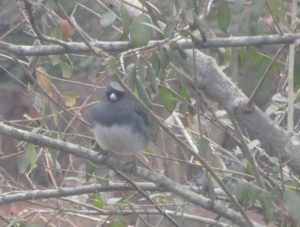
This photograph shows the “dark-eyed” in this dark-eyed junco. This bush in front of my living room window is a fun place to watch birds.
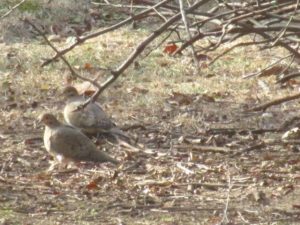
Mourning doves, “Zenaida macroura,” huddled under the flowering quince bush in my backyard.
COASTAL PLAIN BODIES OF WATER: The Jersey Midlands is divided into two geological provinces – the rolling and rocky Piedmont to the west and the flatland, either sandy or gravely, to the east. (The Coastal Plain can be divided into the Outer, or sandy, white soils of the Pine Barrens and beach, and the Inner, the darker, gravely soil conventional farming areas. For the sake of this story, we will talk of the Coastal Plain as one province.) Because of its flatness, there are few, if any, natural bodies of water on the Coastal Plain; Instead, they are human-made, often by dams holding back waterways. In Middlesex County, on the boundary of Helmetta, Monroe, and Spotswood, there is now-dry Lake Marguerite. It was formed by the damming of Manalapan Brook, but has been dry since the 1920s or so. The other day I shot photographs of its old dam.

The remnant of the Lake Marguerite dam on Daniel Road-10th Street on the boundary or Spotswood and Monroe, Middlesex County.

The circa 1906-1907 Lake Marguerite dam.
“OLD JERSEY”: As the Jersey Midlands develop, I am glad to run across “Old Jersey” remnants. Across the street from my house is one of them with an environmental twist – a “Prevent Forest Fires” sign. This sign might be the same one I have seen over all my 61 years. (Just to point out: There has been a different way of thinking on fire. For example, fire is good for the ecology of the Pine Barrens, such as where I live; But it is bad for people.)
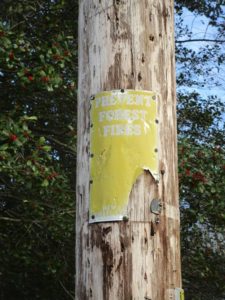
An old “Prevent Forest Fires” sign in my Monroe, Middlesex County, neighborhood.
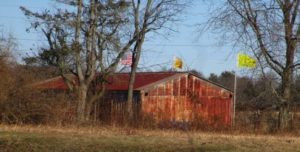
Another “Old Jersey” scene: a farm in Hopewell Township, Mercer County.
SKY VIEWS: This week’s sky views are from Monroe, Middlesex County, and the Manalapan-Freehold Township boundary, Monmouth County.

Monmouth Battlefield State Park on the boundary of Freehold Township and Manalapan, Monmouth County.

Monroe, between Applegarth and Wyckoff’s Mills.
ATLANTIC OCEAN TEMPERATURES: The Atlantic Ocean temperature in New Jersey ranged from about 36 to 37 degrees.
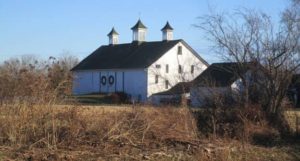
More farming from Hopewell Township Mercer County.
WEATHER: The National Weather Service forecasting office serving the Jersey Midlands is at http://www.weather.gov/phi/.
SUNRISE/SUNSET: For Sunday, January 21, to Saturday, January 27, the sun will rise about 7:10 to 7:15 a.m. and set about 5:05 to 5:10 p.m. For Sunday, January 28, to Saturday, February 3, the sun will rise about 7:05 a.m. to 7:10 a.m. and set about 5:10 p.m. to 5:20 p.m.

The crescent moon over Helmetta Pond, Middlesex County. The crescent moon is waxing toward the January 31 Full Snow Moon.

Ralph “Rusty” Richards, 85-years-old, a mentor of mine in the Pine Barrens around Helmetta, was buried this week in St. James Cemetery in the part of Monroe between Helmetta and Jamesburg, Middlesex County. As his obituary read, “He was an avid woodsman with an extensive knowledge of the local pine barrens….” I left this bough of pitch pine, “Pinus rigida,” the most common pine in the New Jersey Pine Barrens, on Rusty and his wife’s, Mona’s, gravestone. The cemetery is in my neighborhood and Rusty’s grave is a neighbor of my parents’s, Joe Sr. and Sophie Onda Sapia’s, grave. (My maternal family, the Onda-Poznanski family, has known the Richards family for 100 or so years.)
— Joseph Sapia
2018, January 21, Sunday,
A woodsman of the Pine Barrens of Helmetta
Joe Sapia, 61, is a lifelong resident of Monroe — in South Middlesex County, where his maternal family settled more than 100 years ago. He is a Pine Barrens naturalist and an organic gardener of vegetables and fruit, along with zinnias and roses. He draws inspiration on the Pine Barrens around Helmetta from his mother, Sophie Onda Sapia, who lived her whole life in these Pines, and his Polish-immigrant grandmother, Annie Poznanski Onda. He gardens the same backyard plot as did his Grandma Annie and Italian-American father, Joe Sr. Both are inspirations for his food gardening. Ma inspires his rose gardening. Joe is a semi-retired print journalist of almost 40 years. His work also is at @JosephSapia on Twitter.com, along with Facebook.com on the Jersey Midlands page.
Copyright 2018 by Joseph Sapia
Article and photos by Joe Sapia (except where noted)
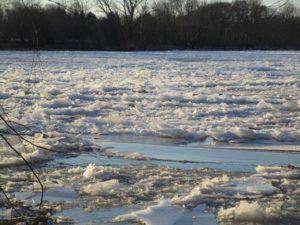
The Delaware River, iced-over Tuesday, January 2, at Washington Crossing — looking from Mercer County, New Jersey, to Bucks County, Pennsylvania, just upstream of the bridge.
SUB-FREEZING DAYS: After days of sub-freezing cold, how cold was it? Cold enough for a waterway – in this case, the mighty Delaware River — to freeze over.
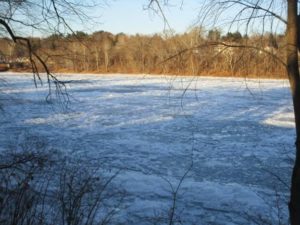
The frozen-over Delaware River Tuesday, January 2, at Washington Crossing, looking from Pennsylvania to New Jersey.

A woman maneuvers Main Street in Cranbury during the Thursday, January 4, snowfall.
SNOWFALL, JANUARY 4: This storm produced a wind-whipped, powdery snow. Snowfall totals reported by National Weather Service:
Burlington County: 3.4 inches at Cinnaminson to 7.5 inches in the Southampton area.
Hunterdon County: 1.9 inches at Readington to 5.8 inches in the Hampton area.
Mercer County: 4.0 inches in the Washington Crossing area to 6.6 inches in the Lawrence area.
Middlesex County: 4.5 inches in the South Brunswick area to 9.6 inches at Cheesequake.
Monmouth County: 9.0 inches at Keyport to 18.0 inches in the West Long Branch area.
Ocean County: 12.5 inches in the Brick area to 18.3 inches in the Berkeley area.
Somerset County: 3.0 inches in the Montgomery area to 5.8 inches in the Franklin area.
(These totals are for these specific stations and may not be complete highs and lows for the counties.)
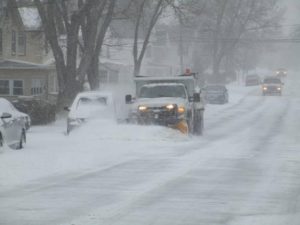
A snowplow pushes snow on Stockton Avenue in Jamesburg, Middlesex County, in the Thursday, January 4, snowfall.
SNOWFALL FOR THE SEASON: With the January 4 snowfall, my house in Monroe, Middlesex County, has had 16 inches of snow, so far this season. The seasonal average at New Brunswick, Middlesex County, or about 7.5 miles from my house, is 25.8 inches. The January 4 snowfall produced 7 inches at my house.
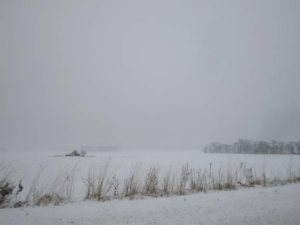
A wind-whipped, snowy field in Monroe, Middlesex County.
WALKING THE SNOWY WOODS: During the Thursday, January 4, storm, I set out from my house about 4:30 p.m., hitting the woods across the street, not wanting to pass up the pristine snowy woods. It was a brief walk, only about 45 minutes from shortly before sunset to shortly after. But I was glad I got to spend a few minutes shooting pictures of nature’s beauty and relaxing in the woods, before shoveling snow. (Weather conditions: Overcast, estimated temperature of 27 degrees, dew point of 5.5 to 6, wind sounding like a freight train.) I got thinking about this short time in the woods. Normally, I do not consider it a hike unless I do at least 3 miles. Perhaps I should re-focus and think about the mental part of the woods and try to get out there daily, even if for only a short time.
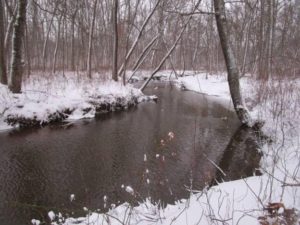
The Old Swimming Hole on Manalapan Brook in Monroe, Middlesex County.
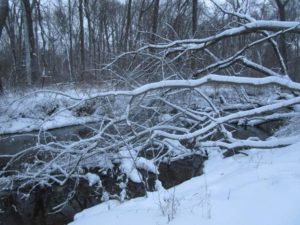
A snow-covered treefall on Manalapan Brook in Monroe, Middlesex County.
SNOW AND THE LAY OF THE LAND: Take advantage of any snow cover. Where there is no snow cover, the woods presents itself as a homogenous picture of earth tones or green leaves – or both. But add a snow-cover; or, better, snow-cover and snow clinging to vegetation; or better yet, snow-cover, snow clinging to vegetation, and foliage and the depth and roll of the land stand out.

The snow-dusted Pine Barrens around Helmetta, Middlesex County – here, specifically, an East Brunswick section of the Jamesburg Park Conservation Area. With the snow contrasting against the earth tones of the woods, it is easy to see the roll of the land.
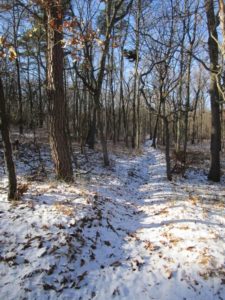
A firecut, plowed by the state Forest Fire Service before a controlled burn here in the Jamesburg Park Conservation Area, is easly seen, along with the rest of the lay of the land, thanks to snow contrasting with the woods’s earth tones.
VOICES FROM AFIELD, EAGLE: Patty Byrnes Lang of Monroe, Middlesex County, checked in with photographs of a bald eagle, “Haliaeetus leucocephalus,” she saw on the boundaries of Monroe, Cranbury/Middlesex County, and East Windsor/Mercer County. In New Jersey, bald eagles are “endangered,” or in immediate jeopardy, as breeders and “threatened,” meaning if conditions persist they could become endangered,” in general. Patty described one encounter, “I caught a glimpse of him in one of the trees on the left. We got to watch as he flew off the branch he was on, circled the field, and landed on another tree.” Based on its coloring, this is an adult. It could be one of the adults that had a nest last year nearby, along the Millstone River in Monroe. This is the time of year eagles begin working on nests.
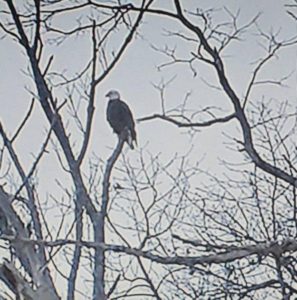
A bald eagle on the boundary of Middlesex and Mercer counties, along the border of Monroe/Middlesex, Cranbury/Middlesex, and East Windsor/Mercer. (Photo copyright 2017 by Patty Byrnes Lang)
VOICES FROM AFIELD, BLUEBIRD: Bob Kane of Cranbury, Middlesex County, checked in with a photograph of an eastern bluebird, “Sialia sialis,” taken in his town. This one is easily identifiable as a male, because of the bright coloring.

A male eastern bluebird at Cranbury, Middlesex County. (Photo copyright 2018 by Bob Kane)
RANCOCAS CREEK: The Rancocas Creek watershed is 360 square miles. It is the only major waterway that flows into the Delaware River from the Pine Barrens. And, despite being freshwater, has a tidal effect; The Delaware River has a tidal effect on its freshwater as far north as Trenton.
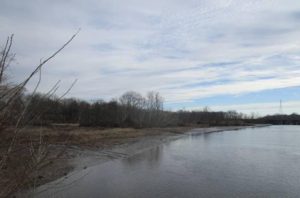
Low tide on Rancocas Creek, looking upstream on the boundary of Mount Laurel, Willingboro, and Westampton, all in Burlington County. Although this is freshwater, there is a tidal effect on the Delaware River and its tributaries as far north as Trenton.
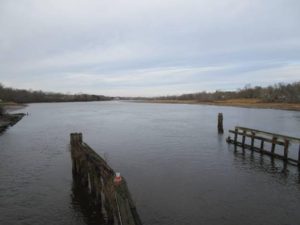
Rancocas Creek, looking downstream at the boundary of Mount Laurel, Willingboro, and Westampton, all Burlington County.
GARDEN WRITING COURSE: This spring, I will be teaching non-fiction writing again at the Princeton Adult School. This time, it will be “Garden Writing,” five sessions on Thursdays, 7 p.m. to 9 p.m., from March 22 to April 26. The class description: “Look at your garden and yard in a different way – through your words. Record your memories in the garden and yard through the essay and vignette. This writing-intensive course has weekly take-home assignments, with the instructor returning critiqued papers. Students will learn writing components, outlining, grammar, style, interviewing, and the importance of resources such as dictionaries and stylebooks – with all assignments focusing on our vegetables, flowers, yards – or afield, if you wish. In-class discussion will cover good examples turned in by students, common problems, and concerns. Feel free to use the class to write a chapter a week of a dream project, work on getting published, keep a journal, or just have fun.” The class costs $99. Enrollment at http://www.ssreg.com/princeton/classes/classes.asp?catID=3679.
ATLANTIC OCEAN TEMPERATURES: The Atlantic Ocean temperature at in New Jersey on the January 6-7 weekend ranged from about 29 to 30 degrees.
WEATHER: The National Weather Service forecasting office serving the Jersey Midlands is at http://www.weather.gov/phi/.
SUNRISE/SUNSET: For Sunday, January 7, to Saturday, January 13, the sun will rise about 7:20 a.m. and set about 4:45 to 4:50 p.m. For Sunday, January 14, to Saturday, January 20, the sun will rise about 7:15 to 7:20 a.m. and set about 4:55 to 5 p.m.
PENNSYLVANIA FARM SHOW: The Pennsylvania Farm Show continues through Saturday, January 13. It is a real-deal show of farming life, not faux farming. So, it has animals, tractors, food preparation, food to buy, gardening displays, and exhibitions. Visitors can get up close to it all. And check out the butter sculpture! (Unfortunately, I will miss the show this year. I had plans to go Wednesday with friends Jimmy and Kathy Krygier of Krygier’s Nursery in South Brunswick, Middlesex County, but work called. I am disappointed, because I look forward to this show.) More information at http://www.farmshow.pa.gov.
COVERING THE WEATHER: During my 31 years as a reporter at the Asbury Park Press, I never saw fellow Metro reporters whine so much about covering something than about weather stories. Me, just the opposite. I loooooooved weather stories. Still do. Was out most of Thursday, January 4, chasing the snow.

Joey on the job, here Tuesday, January 2, photographing the iced-over Delaware River at Washington Crossing, Mercer County.. (Photo copyright 2018 by Pamela B. Roes)
Joe Sapia, 61, is a lifelong resident of Monroe — in South Middlesex County, where his maternal family settled more than 100 years ago. He is a Pine Barrens naturalist and an organic gardener of vegetables and fruit, along with zinnias and roses. He draws inspiration on the Pine Barrens around Helmetta from his mother, Sophie Onda Sapia, who lived her whole life in these Pines, and his Polish-immigrant grandmother, Annie Poznanski Onda. He gardens the same backyard plot as did his Grandma Annie and Italian-American father, Joe Sr. Both are inspirations for his food gardening. Ma inspires his rose gardening. Joe is a semi-retired print journalist of almost 40 years. His work also is at @JosephSapia on Twitter.com, along with Facebook.com on the Jersey Midlands page.
Copyright 2017 by Joseph Sapia
LRWP “Voices of the Watershed” contributor Joe Sapia will be teaching non-fiction writing during the spring 2018 semester at the Princeton Adult School. This semester the theme is “Garden Writing” – writing essays or vignettes about garden, yard, greenhouse, or afield. A description of the course is below:
Look at your garden and yard in a different way – through your words. Record your memories in the garden and yard through the essay or vignette. This writing-intensive course has weekly take-home assignments, with the instructor returning critiqued papers. Students will learn writing components, outlining, grammar, style, interviewing, and the importance of resources such as dictionaries and stylebooks – with all assignments focusing on our vegetables, flowers, yards – or afield, if you wish. In-class discussion will cover good examples turned in by students, common problems, and concerns. Feel free to use the class to write a chapter a week of a dream project, work on getting published, keep a journal, or just have fun.
Garden Writing at the Princeton Adult School,
http://www.ssreg.com/princeton/classes/description.asp?id=106510
http://www.ssreg.com/princeton/classes
Instructor: Joseph Sapia.
Joe Sapia has been a professional non-fiction writer for almost 40 years. He is a retired reporter from the Asbury Park Press. He, now, freelances, including writing a weekly blog, “Garden and Afield in the Jersey Midlands,” along with being an instructor at the Rutgers University Plangere Writing Center. He is an organic vegetable gardener and zinnia grower, using the same 60-year-plus plot used by his Italian-American father and Polish-immigrant grandmother. Joe is a member of the Rutgers Master Gardeners program/Middlesex County.
Joe can answer questions at SnuffTin@aol.com.
Article and photos by Joe Sapia
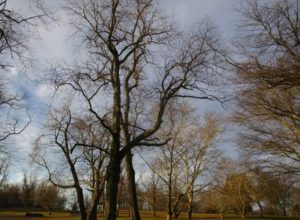
Soft morning sunlight contrasts with threatening skies at the high ground of Thompson Park in Monroe, Middlesex County.
A popular winter activity for generations at Thompson Park is sledding from the high ground toward the low ground around “Jamesburg Lake” (properly Lake Manalapan). The 30-acre lake is formed by the damming of Manalapan Brook at Jamesburg. Remember, there are few, if any, natural bodies of water on the Coastal Plain.

Sledding at Thompson Park in Monroe, Middlesex County, via my 2001 folk art Christmas card.
SNOWFALL: The Saturday, December 30, snowfall of 1.0 inch at my house in the part of Monroe between Helmetta and Jamesburg, Middlesex County, brought the season’s total to 9.0 inches. The seasonal average for New Brunswick, Middlesex County, about 7 miles away, is 25.8 inches. Elsewhere in the Midlands, according to the National Weather Service, with these readings based on what had been reported by reliable spotters at the end of the snowfall and perhaps not comprehensive: Burlington County: a high of 2.5 inches at Florence to a low of 1.5 inches at Moorestown; Hunterdon County: 1.0 inch in Lebanon to .8 inches at Whitehouse Station; Mercer County: 3.2 inches in Hamilton to 2.5 inches in Ewing; Monmouth County: 2.8 inches in the Howell area to .9 inches in Shrewsbury; Somerset County: 1.0 inch in Basking Ridge to .8 inches in Bridgewater; Ocean County: 3.3 in Jackson to 1.5 inches in Toms River.
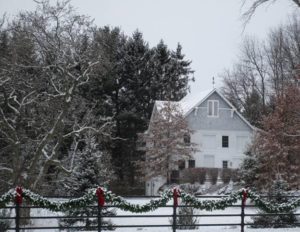
Main Street in Cranbury, Middlesex County, in the Saturday, December 30, snowfall.
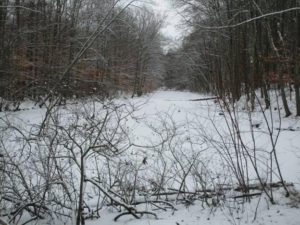
Iced-over and snow-covered Devil’s Brook on the boundary of Plainsboro and South Brunswick, Middlesex County.
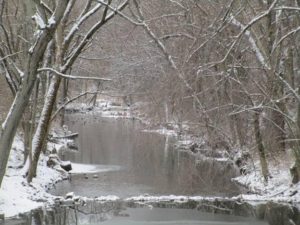
Cranbury Brook as it drains Brainerd Lake (“Cranbury Lake’) in Middlesex County.
SAFE ICE: This time of year, and especially in the hard freeze the Jersey Midlands is in the midst of, we may be tempted to walk out on ice or go skating on it. Be careful! My rule of thumb is the ice must be at least 4-inches-thick. But various factors could come into play, such as warming temperatures, honey-combing, and running water. So, additionally, I look for crystal clear ice or blue-white ice. I am careful of melting ice, snow insulating ice, channels that may run through bodies of water, and fragile ice where water meets land or vegetation.
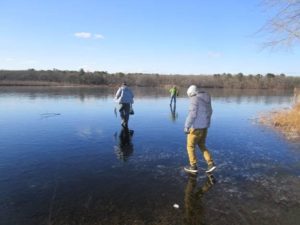
Anglers on an iced-over Helmetta Pond.
ICE SAFETY: If ice is breaking underneath, displace your weight by lying flat. For would-be rescuers, follow this order: throw (a line or flotation device), row (a boat to the person), go (yourself only as a last resort). Probably the soundest advice is to immediately seek help from expert rescuers.
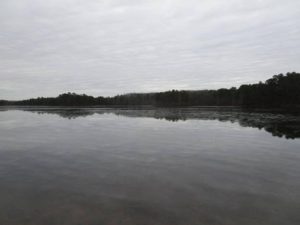
Prospertown Lake in Jackson, Ocean County. The lake is at the northern extreme of the main Pine Barrens.
SWAMP-WALKING: With the sub-freezing high temperatures for an extended period, this is what I look for — a good freeze of the swamps, allowing access to otherwise difficult places to get to. I love swamps!
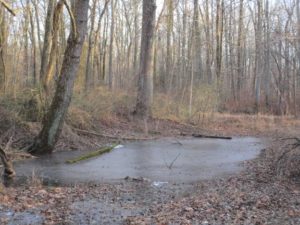
An iced-over wet area in the Manalapan Brook floodplain in Monroe, Middlesex County.
SWAMP-WALKING, No. 2: I started off into the woods across the street from my house – in the Pine Barrens of Monroe, Middlesex County – to do some swamp-walking in the Manalapan Brook floodplain. I did do some, but I got sidetracked when I noticed the abundance of winterberry, genus “Ilex.” I did not get around to making a Christmas wreath or swag, which I decorate with winterberry, but I wound up gathering winterberry to display on its own. I came home with a nice bundle. (To conserve, I broke only one branch from each selected bush.)

Winterberry from the swamp hardwood forest of the Manalapan Brook floodplain on display on my antique kitchen table.
SNOW GEESE: I finally saw some snow geese, “Chen caerulescens,” down from the Arctic as I was driving along the Mercer County-Middlesex County boundary on the border of East Windsor, Cranbury, and Monroe. They were easy to identify by their white bodies and black-tipped wings. There were only a few, rather than a flock. I took a few minutes to see if they were joining a flock on some farmland, but I was going to work and had limited time, finding nothing in my quick search.
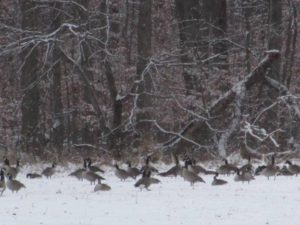
Canada geese, “Branta Canadensis,” is a snow-covered field in South Brunswick, Middlesex County.
ATLANTIC OCEAN TEMPERATURES: The Atlantic Ocean temperature at Sandy Hook on December 30-31 weekend ranged from about 30 to 35 degrees.
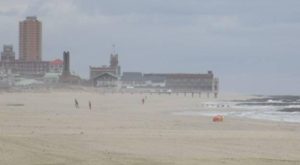
A quiet December Atlantic Ocean beach, looking from Avon-by-the-Sea to Asbury Park, Monmouth County.
MOON: The next full moon, the Full Moon After Yule, is January 1, New Year’s Day.
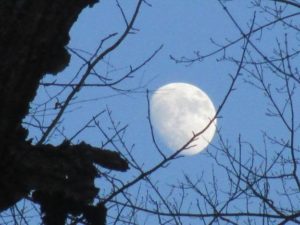
The near-full moon over the swamp hardwood forest of the Manalapan Brook floodplain in Monroe, Middlesex County.
SUNRISE/SUNSET: For Sunday, December 31, to Saturday, January 6, the sun will rise about 7:20 a.m. and set about 4:35 to 4:40 p.m. For Sunday, January 7, to Saturday, January 13, the sun will rise about 7:20 a.m. and set about 4:45 to 4:50 p.m.
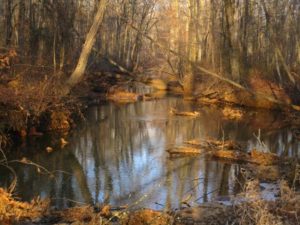
Soft sunlight on Manalapan Brook in Monroe, Middlesex County, as it flows toward Helmetta and Spotswood, also in Middlesex County.
Joe Sapia, 61, is a lifelong resident of Monroe — in South Middlesex County, where his maternal family settled more than 100 years ago. He is a Pine Barrens naturalist and a gardener of organic vegetables and fruit, along with zinnias and roses. He draws inspiration on the Pine Barrens around Helmetta from his mother, Sophie Onda Sapia, who lived her whole life in these Pines, and his Polish-immigrant grandmother, Annie Poznanski Onda. He gardens the same backyard plot as did his Grandma Annie and Italian-American father, Joe Sr. Both are inspirations for his food gardening. Ma inspires his rose gardening. Joe is a semi-retired print journalist of almost 40 years. His work also is at @JosephSapia on Twitter.com, along with Facebook.com on the Jersey Midlands page.
Copyright 2017 by Joseph Sapia
Article and photos by Joe Sapia
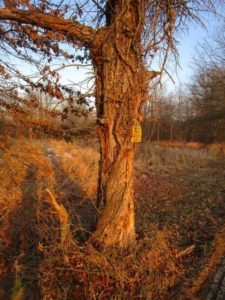
Soft, end-of-the-day sunlight bathes this tree and field on the Pennington-Hopewell Township border, Mercer County. Notice the thick vine – poison ivy, “Toxicodendron radicans” – climbing the tree.
DRIVE-BY NATURALIST, GREAT BLUE HERON: As I was passing Carnegie Lake, which is in the area of Princeton, Mercer County, and Kingston, Somerset-Middlesex counties, I figured I would shoot a photograph of the winter-quiet lake. Quiet? Wrong! As I arrived, a great blue heron, “Ardea herodias,” flew from left to right, landing at the lake. I heard a squawk or squawks, with this heron and another confronting each other, perhaps because these solitary hunters of fish and other aquatic life did not want to share a territory. One flew off, while the other stayed put, providing a subject for my photographs.

As I arrived at Carnegie Lake on the Princeton, Mercer County-Kingston, Middlesex-Somerset counties border, a great blue heron flew in.
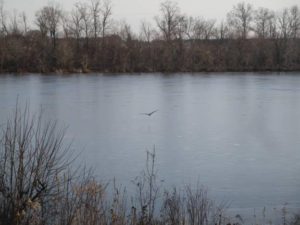 Then, there was a confrontation between two great blues, with one flying off.
Then, there was a confrontation between two great blues, with one flying off.

Remaining was one blue heron, who cooperated nicely for photographs.
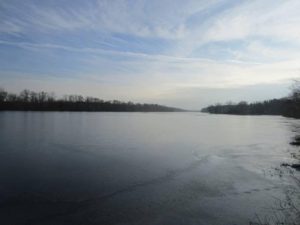
As for the winter calm of Carnegie Lake, it, otherwise, was there.
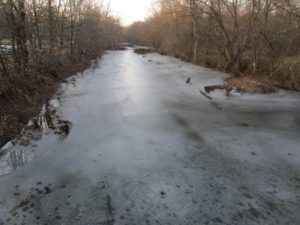
STONY BROOK: Stony Brook meanders for about 22 miles from the Ringoes area of Hunterdon County to the Princeton area of Mercer County, where it empties into the Millstone River. The brook drains approximately 65 square miles.
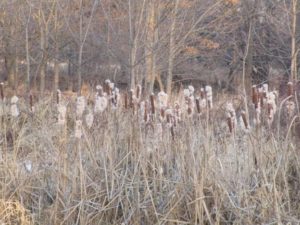
Punks, or cat-tails, genus “Typha,” with their fluffing-out seed heads, in the Stony Brook floodplain in the Pennington-Hopewell Township area, Mercer County.
IF YOU CANNOT GET TO THE ECOSYSTEM, BRING THE ECOSYSTEM TO YOU: Two geological provinces comprise the Jersey Midlands, the rolling hills and rocky Piedmont to the west and the flat, either gravelly or sandy, Coastal Plain to the east. Drive along the flat farmland on the Cranbury-Plainsboro border in Middlesex County and look west to the Princeton area hills in Mercer County, for example, and one would be looking from the Coastal Plain to the Piedmont. So, I was driving through the Pine Barrens around Helmetta and noticed a red shale pile of dirt, dumped on the side of the road in the Jamesburg Park Conservation Area, operated by the Middlesex County Parks and Recreation. Dumping! But this one takes the cake, the apparent dumping of Piedmont fill dirt in a sandy soil area of the Coastal Plain. Back up a truck alongside a road and dump fill dirt that you do not need! I take this as a personal affront because this is my home woods, which my maternal family has walked for more than 100 years, and in Jamesburg Park, where I am a volunteer of several years. The progress of dumping: litter to household debris to a different ecosystem!
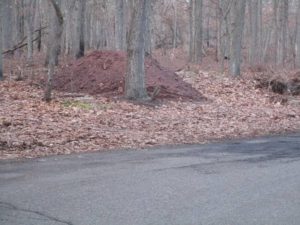
An illegally dumped pile of fill dirt, apparently Piedmont soil dumped in the Coastal Plain of the Pine Barrens around Helmetta, Middlesex County.
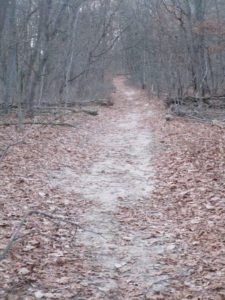
A Jamesburg Park Conservation Area trail of native white, sandy Pine Barrens soil near the dumped load of fill.
SNOW GEESE: I have not noticed any snow geese, “Chen caerulescens,” down from the Arctic. Bob Eriksen, a retired state Division of Fish and Wildlife biologist, checked in from just outside the Midlands in Warren County, saying, “Snow geese arrived, here, later than usual. Huge flocks came in overnight last Wednesday into Thursday morning December 13-14.”
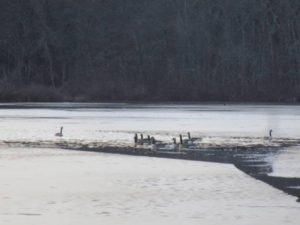
Canada geese, “Branta Canadensis,” on Helmetta Pond, Middlesex County.
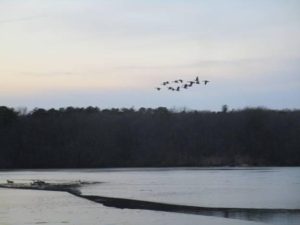
CANADA GEESE: I still stop to look at honking Canada geese, “Branta Canadensis,” in flight. And I get a bigger kick, perhaps, watching them land. While at Helmetta Pond, I noticed geese coming into the lake from the west, then swinging wide to the north and circling in for their landing. What a sight!
WINTER SOLSTICE: With the passing of the Winter Solstice on Thursday, December 21, daylight is increasing.
SNOWFALL TO DATE: To date, 8.0 inches at the Jamesburg-Helmetta area of Middlesex County. In this area, specifically New Brunswick, Middlesex County, the average seasonal total is 25.8 inches.
WEATHER: National Weather Service forecasting, along with other information, for the Jersey Midlands is at http://www.weather.gov/phi/.
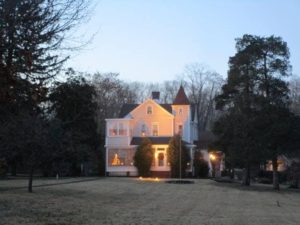
Merry Christmas from Helmetta. Here, the old Clemons house, one of the mansions associated in the 20th Century with the George W. Helme Snuff Mill — in this case, belonging to one of the mill’s upper level managers. According to house owner Carol Bohinski, “The Clemons mansion was built in 1890 by Arthur Clemons, brother-in-law to George W. Helme. Helme’s grandson, Arthur Helme Clemons, was a Helme Company President.”
Joe Sapia, 61, is a lifelong resident of Monroe — in South Middlesex County, where his maternal family settled more than 100 years ago. He is a Pine Barrens naturalist and a gardener of organic vegetables and fruit, along with zinnias and roses. He draws inspiration on the Pine Barrens around Helmetta from his mother, Sophie Onda Sapia, who lived her whole life in these Pines, and his Polish-immigrant grandmother, Annie Poznanski Onda. He gardens the same backyard plot as did his Grandma Annie and Italian-American father, Joe Sr. Both are inspirations for his food gardening. Ma inspires his rose gardening. Joe is a semi-retired print journalist of almost 40 years. His work also is at @JosephSapia on Twitter.com, along with Facebook.com on the Jersey Midlands page.
Copyright 2017 by Joseph Sapia
Article and photos by Joe Sapia
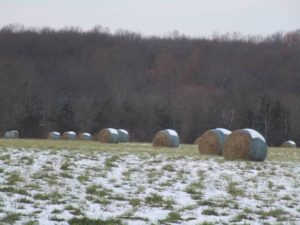
Fall meets winter with rolls of hay awaiting harvest on snow-covered farmland on the Princeton Ridge in Hopewell Township, Mercer County. The Princeton Ridge is one of three well-known pieces of hilly ground just north of downtown Princeton, the other two being Sourland Mountain and the Kingston Ridge.
SEASON’S FIRST SNOWFALL: My house in Monroe, Middlesex County, got its first snowfall of the season, this week – actually three snowfalls! The individual totals were December 9-10, Saturday-Sunday, 5.0 inches; December 13-14, Wednesday-Thursday, 1.5 inches; and December 15, Friday, 1.5 inches. All told, 8.0 inches. In my area, specifically New Brunswick, the average seasonal total is 25.8 inches.
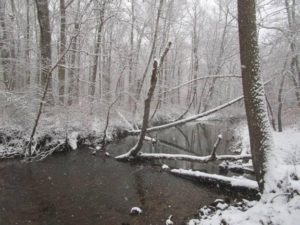 Snow falls along Manalapan Brook in Monroe, Middlesex County, during the season’s first snowfall, December 9-10, Saturday-Sunday. This locale is only a few hundred feet from my front door and I remember walking to this part of “The Brook” with my father when I was about 4-years-old, or more than 55 years ago.
Snow falls along Manalapan Brook in Monroe, Middlesex County, during the season’s first snowfall, December 9-10, Saturday-Sunday. This locale is only a few hundred feet from my front door and I remember walking to this part of “The Brook” with my father when I was about 4-years-old, or more than 55 years ago.
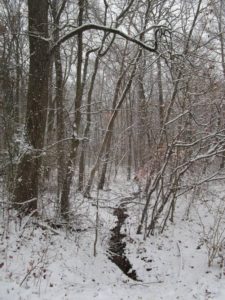
A stream cuts its way through the Manalapan Brook floodplain in Monroe, Middlesex County, during the first snowfall, December 9-10, Saturday-Sunday. This locale, at the bottom of my street, is what I have always known as “The Swamp.”
SNOWFENCING: As we travel through the Jersey Midlands, we may see snow-fencing in place to prevent drifting across roadways. The idea is to get the fencing up before it snows and hope it does not snow after farmers need to get in their fields for spring plowing or, that is, before it ends snowing for the season.
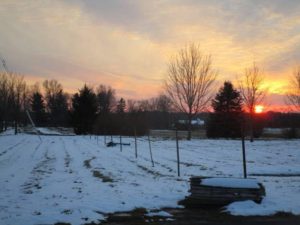
In Hopewell Township, Mercer County, this snow-fence was not up in time for the December 9-10, Saturday-Sunday, snowfall. Stakes in place, yes. Actual fencing, no.
GEMINID METEOR SHOWER: The Geminid Meteor Shower on the Wednesday-Thursday, December 13-14, overnight was a washout for me because of cloudy skies. More disappointing, because during that overnight, I was driving home from Baltimore and was hoping to be entertained for 2-1/2 to 3 hours. But that was a snowy night, so the viewing was not to be. Did anybody get lucky and see meterors?
‘SNOWBIRDS’ IN THE GARAGE: As I work in the yard or go between my house and my Jeep, I often leave the garage doors open. Occasionally over the years, I find a bird in the garage – seemingly always a “snowbird,” or dark-eyed junco, “Junco hyemalis,” birds that travel from as far away as Canada to stay from fall to spring. Most recently, I found one in the garage this week. Why seemingly always a snowbird in the garage? I do not know. Any thoughts?

A snowbird sits on top of my backyard birdfeeder while snow falls Friday, December 15, in Monroe, Middlesex County. American holly, “Ilex opaca,” is in the foreground.
AROUND THE BACKYARD: I sitting at my desk, in a corner room with windows facing north from the side of the house and facing west into the backyard, when I heard a wheezing call. A hawk? I looked into the backyard and saw no birds around the feeder or elsewhere in the backyard. However, I did notice a squirrel, “Sciurus carolinensis,” on the pole holding the feeder. The squirrel was frozen in place, facing downward, or in fleeing position. Yes, I thought, that probably was a hawk I heard. When the predator is around, the lucky prey flees.
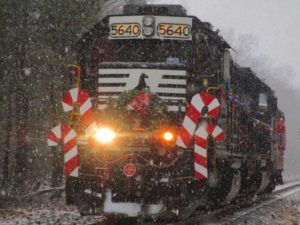
The annual ConRail Santa Train rumbled through Monroe, Middlesex County, this time while it is snowing December 9, Saturday. The Santa Train is especially fulfilling to me because it is a tradition of about 35 years; passes on railroad tracks my family has lived along for more than 100 years, as close as bordering the property and as far as my house, a quarter-mile; and, I have loved the freights on this line since my childhood days of the mighty Pennsylvania Railroad. It passes on the former line of the Camden-Amboy Railroad, the first railroad in the country, in the early 1830s, to replace equine power with mechanical power.
VOICES FROM AFIELD, CHRISTINE DENNELER: Christine Denneler, one of my Pine Barrens mentors over the last 35 years, checked in, regarding hunting: “Since most of my husband’s family is gone, hunting is not talked about at the holiday table as it was in the old days. (Late husband) Bill was not an avid hunter as was his grandpop, but he and his father liked the camaraderie.” (Chris has been a backbone of hiking in the Outdoor Club of South Jersey, www.ocsj.org, for decades. To go on a Chris Denneler hike is to learn the Pine Barrens.)
TONY’S FARM AND GARDEN CENTER: I was driving home from South Jersey and took advantage of passing Tony’s Farm and Garden Center — started and run by the Ciaccio family in Robbinsville, Mercer County, since 1946 — by stopping in. I have been patronizing Tony’s – in my case, for houseplants, vegetable plants, and garden supplies – for decades. It is one of my favorite places in the Jersey Midlands. Not only was it holding on to the 2017 gardening season, but it was decked out for Christmas. So, I bought a Christmas cactus – my first shot at one, so let us see if I can keep it alive – and two devil’s ivy houseplants – which even I have a hard time killing. (A shout-out to Ciaccio family members, especially young Tony, for their quality products and service and friendliness. Tony’s is one of my main sources for gardening information.)

Wreaths at Tony’s Farm and Garden Center in Robbinsville, Mercer County.

Poinsettias at Tony’s Farm and Garden Center

Christmas cactuses at Tony’s Farm and Garden Center.
VOICES FROM AFIELD, PRISCILLA “PEPPY” BATH: Outdoorswoman Priscilla “Peppy” Bath checked in on hiking Jake’s Branch County Park in the Ocean County Pine Barrens: “I have never before been to the park and it is beautiful with many well-marked trails. We hiked the Blue (Trail) 4-mile hike. Alongside of the trail were many patches of trailing arbutus (“Epigaea repens”) and also turkey beard (“Xerophyllum asphodeloides”). Neither was in bloom, but I will go back in the spring and see the beautiful flowers.” More information on Jake’s Branch Park is available at http://www.oceancountyparks.org/ContentPage.aspx?ID=0694b294-986f-46e6-a679-d03ac775c176.
‘SNOW GEESE’: This time of year, we can expect to see snow geese, “Chen caerulescens,” down from the Arctic tundra – perhaps flying by, noticeable by their white color and black-tipped wings, or in farm fields. So far, I have not seen any, but hope to. (The species also has a dark version, or the “blue goose.”)
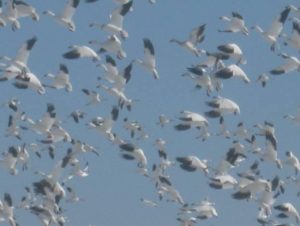
I took this photo of snow geese a few years ago on farmland along the Cranbury-Plainsboro boundary in Middlesex County. Here, their white bodies and black wingtips, which provide easy identification, are easily seen.
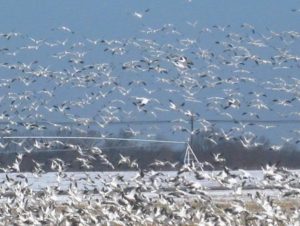
Another photograph of snow geese from a few years ago. Here, both in flight and in a cornfield.
TUNDRA SWANS: Tundra swans, “Cygnus buccinators” – New Jersey’s only native swan — are in the area. They, too, are cold-weather visitors from the Arctic tundra. My favorite place to see them is Whitesbog, in the main Pine Barrens and part of Brendan T. Byrne State Forest. Here is a story about Tundra Swan No. 207, spotted this season at Whitesbog, http://birdquiz.net/t207-2017/.
THE QUIET OF WINTER: In the winter, with many people staying inside in the warmth, the outdoors has a quiet solitude in many spots. Two places I visited during the week come to mind, the Delaware and Raritan Canal, where I visited the canal in Franklin Township, Somerset County, and the confluence of Crosswicks Creek and the Delaware River at Bordentown City, Burlington County.
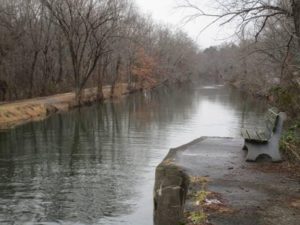
The Delaware and Raritan Canal at Griggstown in Franklin, Somerset County.

Crosswicks Creek at Bordentown City, Burlington County.
ATLANTIC OCEAN TEMPERATURES: The Atlantic Ocean temperature at Sandy Hook on December 17, Sunday, ranged from about 36 to 40 degrees.
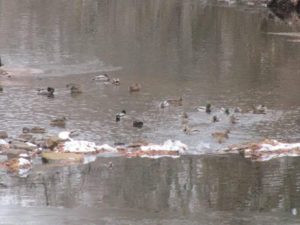
Mallard ducks, “Anas platyrhynchos,” on Cranbury Brook in Cranbury, Middlesex County.
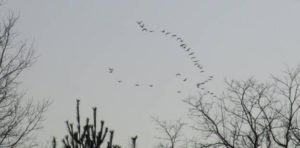
A familiar sound is the honking, then sighting, of Canada geese, “Branta Canadensis,” I captured this photograph from my backyard in Monroe, Middlesex County.
SUNRISE/SUNSET: For Sunday, December 17, to Saturday, December 23, the sun will rise about 7:15 to 7:20 a.m. and set about 4:25 p.m. For Sunday, December 24, to Saturday, December 30, the sun will rise about 7:20 a.m. and set about 4:35 to 4:40 p.m.
WINTER SOLSTICE: The Winter Solstice, or the day with the least amount of daylight, is December 21, Thursday. The sun rises about 7:17 a.m. and sets about 4:35 p.m. After, the amount of daylight grows until June 21, the “longest day” of the year.
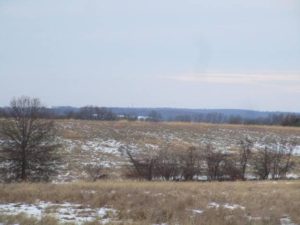
A view of Sourland Mountain, which is on the boundary of Somerset, Mercer, and Hunterdon counties, in the background across the farmland. This is as seen from the Princeton Ridge, Mercer County.
WEATHER: National Weather Service forecasting, along with other information, for the Jersey Midlands is at http://www.weather.gov/phi/.
UNEXPECTED WILDLIFE REFUGE SEEKS VOLUNTEERS: Our friends at the Unexpected Wildlife Refuge, just south of the Jersey Midlands in Gloucester County, seek volunteers to patrol the property to keep hunters off until at least the end of January. If interested, contact the refuge, http://unexpectedwildliferefuge.org/.
 Snow clings to an American holly, “Ilex opaca,” in my backyard in Monroe, Middlesex County, from the December 9-10, Saturday-Sunday. This was the first snowfall of the season at my house.
Snow clings to an American holly, “Ilex opaca,” in my backyard in Monroe, Middlesex County, from the December 9-10, Saturday-Sunday. This was the first snowfall of the season at my house.
Joe Sapia, 61, is a lifelong resident of Monroe — in South Middlesex County, where his maternal family settled more than 100 years ago. He is a Pine Barrens naturalist and a gardener of organic vegetables and fruit, along with zinnias and roses. He draws inspiration on the Pine Barrens around Helmetta from his mother, Sophie Onda Sapia, who lived her whole life in these Pines, and his Polish-immigrant grandmother, Annie Poznanski Onda. He gardens the same backyard plot as did his Grandma Annie and Italian-American father, Joe Sr. Both are inspirations for his food gardening. Ma inspires his rose gardening. Joe is a semi-retired print journalist of almost 40 years. His work also is at @JosephSapia on Twitter.com, along with Facebook.com on the Jersey Midlands page.
Copyright 2017 by Joseph Sapia
Article and photos by Joe Sapia
Note: The yard references are to my house in the section of Monroe between Helmetta and Jamesburg in South Middlesex County. My yard is in a Pine Barrens outlier on the Inner Coastal Plain, the soil is loamy, and my neighborhood is on the boundary of Gardening Zones 6b (cooler) and 7a (warmer). Notes and photographs are by the author and for the period covered, unless otherwise noted.
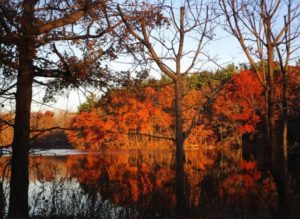 The foliage change of colors may be past its peak, but the colors continue to dazzle. Here, morning sunlight shines on a cove in a section of Farrington Lake on the East Brunswick-North Brunswick boundary in Middlesex County.
The foliage change of colors may be past its peak, but the colors continue to dazzle. Here, morning sunlight shines on a cove in a section of Farrington Lake on the East Brunswick-North Brunswick boundary in Middlesex County.
VOICES FROM AFIELD, DIANE LARSON, EAGLES: Diane Larson, who lives along Beaver Dam Creek in Brick, Ocean County, checked in: “Just wanted to share what happened (Sunday, November 26) morning. We noticed the seagulls abruptly flying, like they were spooked, then saw these two guys flying right above our house, and landed on the house across the lagoon from us!” Bald eagles, “Haliaeetus leucocephalus.” In New Jersey, the species is “endangered” as a breeder, or in immediate peril, and “threatened” otherwise, meaning if conditions continue, it could become “endangered.” “They flew in the area all morning, it was awesome to watch,” Diane said.
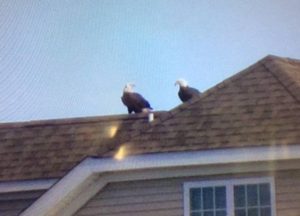
Two bald eagles in the Beaver Dam Creek area of Brick, Ocean County. (Photograph copyright 2017 by Diane Larson)
MORE EAGLES: Michael Franken has been reporting bald eagles from the boundary of Cranbury and Plainsboro in Middlesex County.
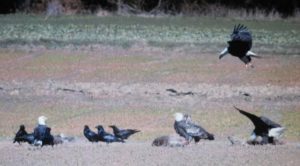
Bald eagles on a deer carcass along the Cranbury-Plainsboro boundary in Middlesex County. (Photo copyright 2017 by Michael Franken Photography)
VOICES FROM AFIELD, DIANE LARSON, NO. 2, JUNCOS: Diane Larson, who is the home horticulturist for the Monmouth County office of the Rutgers University Cooperative Extension, said, “I just went out to the back to check on the gardens behind our office. I heard unfamiliar bird sounds and followed them to see dozens of juncos (“Junco hyemalis,” or snowbird) on a tree back there. I then saw why they were there. They were all around the sweetgum tree (“Liquidambar styraciflua”) eating the seeds from the sweetgum balls.”
SNOWY OWLS: Reports are coming in of snowy owls, “Bubo scandiacus,” down from the Arctic. In recent years, I have heard two theories on the uptick of snowy owls in our area, both related to their food of choice, lemmings, “Dicrostonyx torquatus.” One is that there could be a shortage of lemmings, so the owls migrate farther than normal to find food. The other theory is there was an abundance of lemmings and because of this, owls prospered, having more offspring. A snowy owl story from nj.com: http://www.nj.com/ocean/index.ssf/2017/11/snowy_owl_explosion_expected_in_new_jersey_this_ye.html.
DRIVE-BY NATURALIST, STARLINGS: As I was walking through the Rutgers University campus in downtown New Brunswick, Middlesex County, I encountered a flock of starlings, flying and perching in trees. “For much of the year, they wheel through the sky and mob lawns in big, noisy flocks,” according to Cornell University’s All About Birds website. Starlings, “Sturnus vulgaris,” are non-native. “First brought to North America by (playwright William) Shakespeare enthusiasts in the 19th Century, European Starlings are now among the continent’s most numerous songbirds,” according to All About Birds.
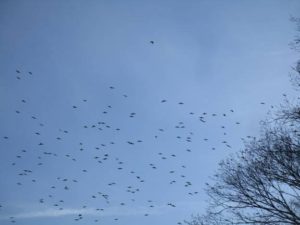
A flock of starlings at Rutgers University in New Brunswick, Middlesex County.
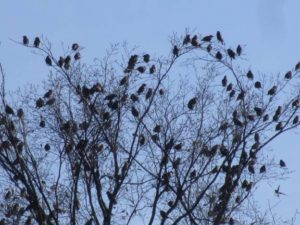
Perched starlings at Rutgers University in New Brunswick, Middlesex County.
DRIVE-BY NATURALIST, SUNSET: As I was headed to the Rocky Hill area of Somerset County, I came across a beautiful sunset on the Monroe-South Brunswick boundary in Middlesex County. It was a wonderful orange sky, with the farmland I was photographing across providing “big sky” views.

Sunset on the boundary of Monroe and South Brunswick, Middlesex County.
EARTHQUAKE: On Thursday, November 30, the rumble you may have felt was a 4.1 earthquake centered near Dover, Delaware. The Did-You-Feel-It response to the United States Geological Survey, https://earthquake.usgs.gov/earthquakes/eventpage/us1000bjkn#dyfi.
HURRICANE SEASON: The Atlantic Ocean hurricane season ended Thursday, November 30. During the season, which began June 1, there were 17 named storms of which 6 were major hurricanes, according to Channel 6 television in Philadelphia. “Three Category 4 hurricanes” – those with winds of 130 to 156 miles per hour — “made US landfall,” according to Channel 6. A primer on hurricanes from the National Hurricane Center, http://www.nhc.noaa.gov/aboutsshws.php.
‘LIVING SHORELINES’ PROPOSAL: Congressman Frank Pallone, who lives in Long Branch, is to introduce legislation creating the Living Shorelines Act, which would provide federal grant money for building up shorelines with plants and other natural materials. The idea is to prevent flooding and erosion, along with providing habitat, in a natural way. See Pallone’s op-ed in the Wednesday, November 29, Asbury Park Press, http://www.app.com/story/opinion/columnists/2017/11/29/living-shorelines-act-frank-pallone/108143866/.
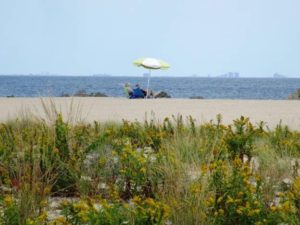
In this 2016 photograph, an Atlantic Ocean natural beach at Sandy Hook, Monmouth County, with the New York City area in the background.
CHRISTMAS TREES, SLIM PICKINGS AND HIGHER PRICES: We were just talking about how fewer trees were planted because of the Great Recession about 10 years ago. And, 10 years later, those trees are ready – in smaller numbers and, in turn, higher prices. Here is a New York Times story on the matter, https://www.nytimes.com/2017/11/30/business/christmas-tree-shortage-recession.html.
DEER RUT: A 63-year-old Franklin, Somerset County, died from injuries suffered in a motor-vehicle accident in his hometown that happened during the ongoing mating season, or rut, of deer, “Odocoileus virginianus.” Be careful while driving, especially during the rut, which will likely extend into about mid-December.
FULL MOON: The upcoming full moon — the Full Long Night Moon on the December 3-4, Sunday-Monday overnight — will be 2017’s only full “super moon,” that is, when the full moon comes close to the Earth, or 222,443 miles away. The closest will be at 4 a.m. Monday, December 4, when the moon will appear “about 7 percent larger and 16 percent brighter than usual,” according to the National Geographic.

The near-full moon around 4 a.m. from my backyard in Monroe, Middlesex County.
OCEAN TEMPERATURE: The Atlantic Ocean temperature at Sandy Hook was about 48 degrees over the Dec. 2-3 weekend.
SUNRISE/SUNSET: For Sunday, December 3, to Saturday, December 9, the sun will rise about 7:05 to 7:10 a.m. and set about 4:30 p.m. For Sunday, December 10, to Saturday, December 16, the sun will rise about 7:10 to 7:15 a.m. and set about 4:30 to 4:35 p.m.
WEATHER: The National Weather Service forecasting station for the area is at http://www.weather.gov/phi/.
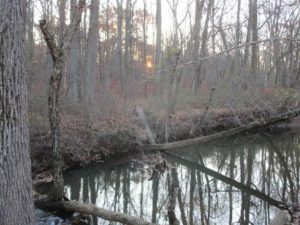
Sunrise at Manalapan Brook in Monroe, Middlesex County.
Joe Sapia, 61, is a lifelong resident of Monroe — in South Middlesex County, where his maternal family settled more than 100 years ago. He is a Pine Barrens naturalist and a gardener of organic vegetables and fruit, along with zinnias and roses. He draws inspiration on the Pine Barrens around Helmetta from his mother, Sophie Onda Sapia, who lived her whole life in these Pines, and his Polish-immigrant grandmother, Annie Poznanski Onda. He gardens the same backyard plot as did his Grandma Annie and Italian-American father, Joe Sr. Both are inspirations for his food gardening. Ma inspires his rose gardening. Joe is a semi-retired print journalist of almost 40 years. His work also is at @JosephSapia on Twitter.com, along with Facebook.com on the Jersey Midlands page.
Copyright 2017 by Joseph Sapia





















































































































































